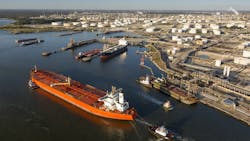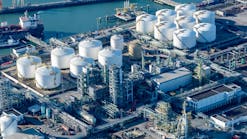ExxonMobil secures technologies for Baytown blue hydrogen project
ExxonMobil Corp. has let separate contracts to Topsoe AS and Honeywell UOP LLC to deliver critical technologies for the operator’s proposed plan to build a grassroots low-carbon hydrogen production plant and carbon capture and storage (CCS) plant at its 561,000-b/d integrated refining and petrochemical complex in Baytown, Tex., along the Houston Ship Channel (OGJ Online, Mar. 3, 2022).
As part of the first Feb. 15 contract, Haldor will license its proprietary SynCOR hydrogen technology that—based on advanced autothermal reforming principles—will enable the complex to produce 1 bcfd of low-carbon (blue) hydrogen—or hydrogen produced by converting natural gas into hydrogen and carbon dioxide (CO2) in the presence of steam—allowing for lower capital and operating costs, as well as cost-efficient carbon capture at the site, the service provider said.
As technology integrator, Topsoe said its scope of work on the project includes guaranteeing the carbon intensity of both the hydrogen produced and carbon captured at the integrated low-carbon complex.
To ensure delivery of an integrated solution, Topsoe also confirmed it has teamed up with fellow mid-February contract awardee Honeywell UOP, which will license its proprietary CO2 fractionation and hydrogen purification system for the proposed complex’s capture of about 7 million tonnes/year (tpy) of CO2—equivalent to more than 98% of the site’s annual associated CO2 emissions—for subsequent sequestration and permanent storage underground.
Honeywell UOP said implementation of its advanced-solvent CO2 and hydrogen technology at the Baytown complex will allow ExxonMobil to further reduce costs and increase efficiency associated with its capturing, transportation, and storage of CO2.
Neither Topsoe nor Honeywell UOP provided details regarding the value of the recently awarded contracts.
Part of ExxonMobil’s strategy to reduce emissions from its own and local industry operations, the proposed Baytown low-carbon hydrogen, ammonia, and CCS plant would allow the site to manufacture lower-emissions products for its own customers but also make surplus volumes of hydrogen and ammonia, as well as CO2 storage capacity, available to nearby industry.
While it does not plan to reach a final investment decision (FID) on the development until 2024, ExxonMobil recently said it has already started discussions with third-party customers for offtake agreements from the project that, if approved, would reach startup in 2027-28 (OGJ Online, Jan. 31, 2023).
Upon first announcing the project in March 2022, ExxonMobil said use of hydrogen produced by the planned project as a fuel at the Baytown olefins plant could reduce the integrated complex’s CO2 emissions as defined by Scope 1 and Scope 2 of the Greenhouse Gas (GHG) Protocol Corporate Accounting and Reporting Standard by up to 30%, supporting the operator’s ambition to achieve net-zero GHG emissions from its operated assets by 2050.
Alongside myriad finished petroleum products supplied by its refining operations, ExxonMobil’s Baytown integrated complex also produces 4 million tpy of ethylene, 700,000 tpy of polypropylene, and 600,000 tpy of paraxylene.

Robert Brelsford | Downstream Editor
Robert Brelsford joined Oil & Gas Journal in October 2013 as downstream technology editor after 8 years as a crude oil price and news reporter on spot crude transactions at the US Gulf Coast, West Coast, Canadian, and Latin American markets. He holds a BA (2000) in English from Rice University and an MS (2003) in education and social policy from Northwestern University.


